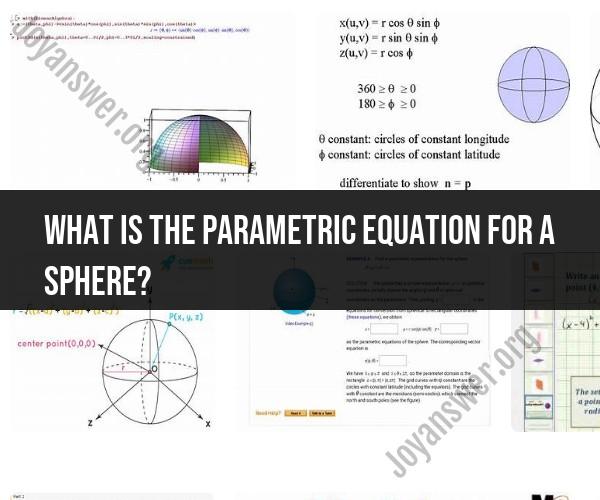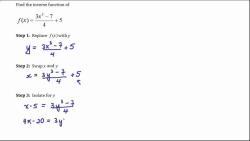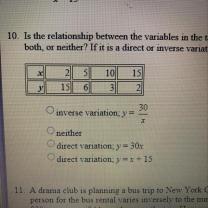What is the parametric equation for a sphere?
The parametric equation for a sphere in three-dimensional space is typically given by a set of three equations, one for each coordinate (x, y, and z), using two parameters (usually denoted as θ and φ) that vary within specific ranges. These parameters describe points on the sphere's surface. The parametric equations for a sphere of radius "r" centered at the origin (0, 0, 0) are as follows:
- x(θ, φ) = r * sin(φ) * cos(θ)
- y(θ, φ) = r * sin(φ) * sin(θ)
- z(θ, φ) = r * cos(φ)
In these equations:
- (x, y, z) represents the Cartesian coordinates of a point on the sphere's surface.
- θ (theta) varies from 0 to 2π (i.e., a full circle, covering 360 degrees) and represents the azimuthal angle, which measures the rotation around the z-axis.
- φ (phi) varies from 0 to π (i.e., half of a full circle, covering 180 degrees) and represents the polar angle, which measures the angle from the positive z-axis to the point on the sphere.
By varying θ and φ within their specified ranges, you can generate all points on the surface of the sphere. Different values of θ and φ will correspond to different points on the sphere, allowing you to parameterize the entire sphere.
It's worth noting that these parametric equations are often used for mathematical representations and computer graphics. In practice, if you need to work with spheres, you might use other forms, such as the standard equation for a sphere centered at (h, k, l) with radius "r":
[(x - h)^2 + (y - k)^2 + (z - l)^2 = r^2]
This equation describes the sphere in a more algebraic form, where (x, y, z) are the Cartesian coordinates of any point on the sphere.
Exploring Spheres in Mathematics: Parametric Equations Unveiled
Spheres are one of the most fundamental shapes in mathematics, and their many properties have been studied by mathematicians for centuries. One way to explore the geometry of spheres is through the use of parametric equations.
A parametric equation is a set of equations that defines a curve or surface in terms of two or more independent variables. In the case of a sphere, we can use three independent variables to define a parametric equation that describes the surface of the sphere.
One common parametric equation of a sphere is as follows:
x = r cos(θ) sin(φ)
y = r sin(θ) sin(φ)
z = r cos(φ)
where:
ris the radius of the sphereθis the longitude angleφis the latitude angle
The longitude angle θ ranges from 0 to 2π, and the latitude angle φ ranges from 0 to π. This means that the parametric equation describes the entire surface of the sphere.
Mathematical Beauty: Understanding the Parametric Equation of a Sphere
The parametric equation of a sphere is a beautiful and elegant way to describe the geometry of this fundamental shape. It allows us to see the sphere as a continuous surface that can be generated by varying two independent parameters.
The parametric equation also reveals some of the hidden symmetries of the sphere. For example, if we rotate the sphere by 180 degrees about the x-axis, the sphere will look the same. This is reflected in the parametric equation, since if we substitute -θ for θ and π - φ for φ, we get the same equation.
Geometry Made Clear: Parametric Representation of a Sphere
The parametric representation of a sphere can be used to solve a variety of geometrical problems. For example, we can use it to find the surface area or volume of a sphere, or to calculate the distance between two points on the surface of a sphere.
We can also use the parametric representation to generate computer graphics of spheres. This is useful for a variety of applications, such as video games, movies, and scientific simulations.
Conclusion
The parametric equation of a sphere is a powerful tool for exploring the geometry of this fundamental shape. It is a beautiful and elegant equation that reveals some of the hidden symmetries of the sphere. The parametric representation of a sphere can also be used to solve a variety of geometrical problems and to generate computer graphics of spheres.












